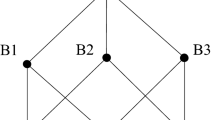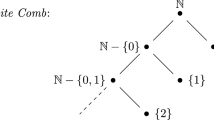Abstract
It is customary practice to define ‘x is composed of the ys’ as ‘x is a sum of the ys and the ys are pairwise disjoint (i.e., no two of them have any parts in common)’. This predicate has played a central role in the debate on the special composition question and on related metaphysical issues concerning the mereological structure of objects. In this note we show that the customary characterization is nonetheless inadequate. We do so by constructing a mereological model where everything qualifies as composed of atoms even though some elements in the domain are gunky, i.e., can be divided indefinitely into smaller and smaller proper parts.

Similar content being viewed by others
Notes
Or, if one wishes to avoid plural quantification and stick to a standard first-order syntax, the analogous but weaker predicate ‘x is composed of the φs’, where ‘φ’ is an open formula.
This is because any element in D M of the form I ∪ P is such that the position of I in the binary tree rooted at G is exactly the same as the position of P in the binary tree rooted at A. For, suppose x ∩ G ⊆ y. Then x ∩ G must be in the sub-tree rooted at y ∩ G. But then x ∩ A will be in the sub-tree rooted at y ∩ A. Hence x ∩ A ⊆ y ∩ A ⊆ y. Similarly, if x ∩ A ⊆ y, we must have x ∩ G ⊆ y ∩ G ⊆ y.
References
Cotnoir, A. J. (2013). Beyond atomism. Thought, 2, 67–72.
Leonard, H. S., & Goodman, N. (1940). The calculus of individuals and its uses. Journal of Symbolic Logic, 5, 45–55.
Leśniewski, S., (1927–1931). O podstawach matematyki, Przegląd Filozoficzny, 30: 164–206; 31: 261–291; 32: 60–101; 33: 77–105; 34: 142–170; On the foundations of mathematics (D. I. Barnett, Eng. Trans.). In S. Leśniewski, S. J. Surma et al. (Eds.). Collected works, Dordrecht: Kluwer, 1992, Vol. 1, pp. 174–382.
Shiver, A. (2015). How do you say “everything is ultimately composed of atoms”? Philosophical Studies, 172, 607–614.
Simons, P. M. (1987). Parts. A study in ontology. Oxford: Clarendon Press.
van Inwagen, P. (1990). Material beings. Ithaca (NY): Cornell University Press.
Varzi, A. C. (2015). Mereology. In E. Zalta (Ed.). The Stanford encyclopedia of philosophy, Spring 2015 edition, http://plato.stanford.edu/archives/spr2015/entries/mereology.
Acknowledgments
Many thanks to two anonymous referees for very helpful comments on an earlier draft of this paper, which led to substantive revisions. Part of this work was carried out within research project NSC 101-2410-H-194-033-MY3, kindly funded by the Ministry of Science and Technology of Taiwan.
Author information
Authors and Affiliations
Corresponding author
Rights and permissions
About this article
Cite this article
Tsai, Hc., Varzi, A.C. Atoms, Gunk, and the Limits of ‘Composition’. Erkenn 81, 231–235 (2016). https://doi.org/10.1007/s10670-015-9736-z
Received:
Accepted:
Published:
Issue Date:
DOI: https://doi.org/10.1007/s10670-015-9736-z




